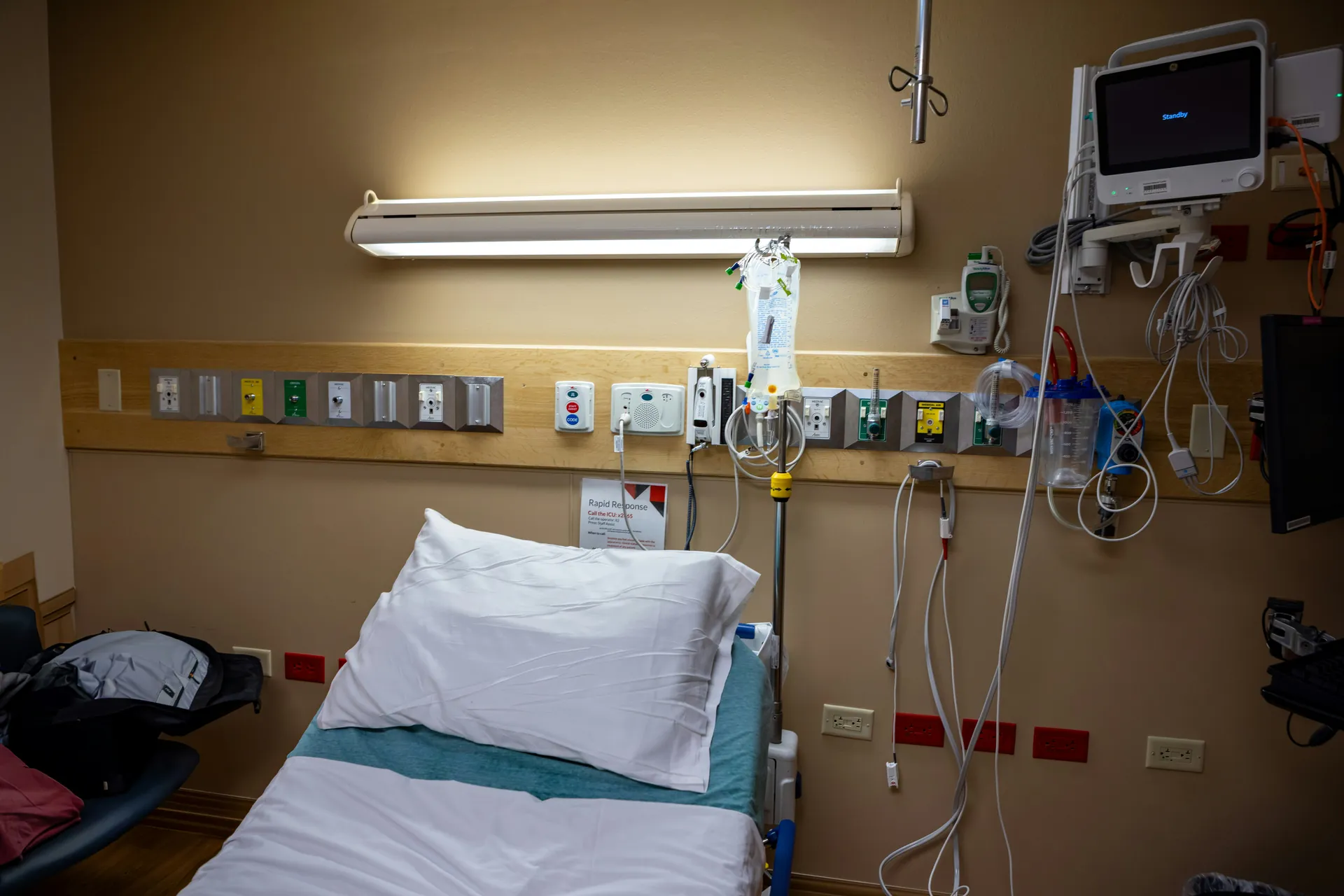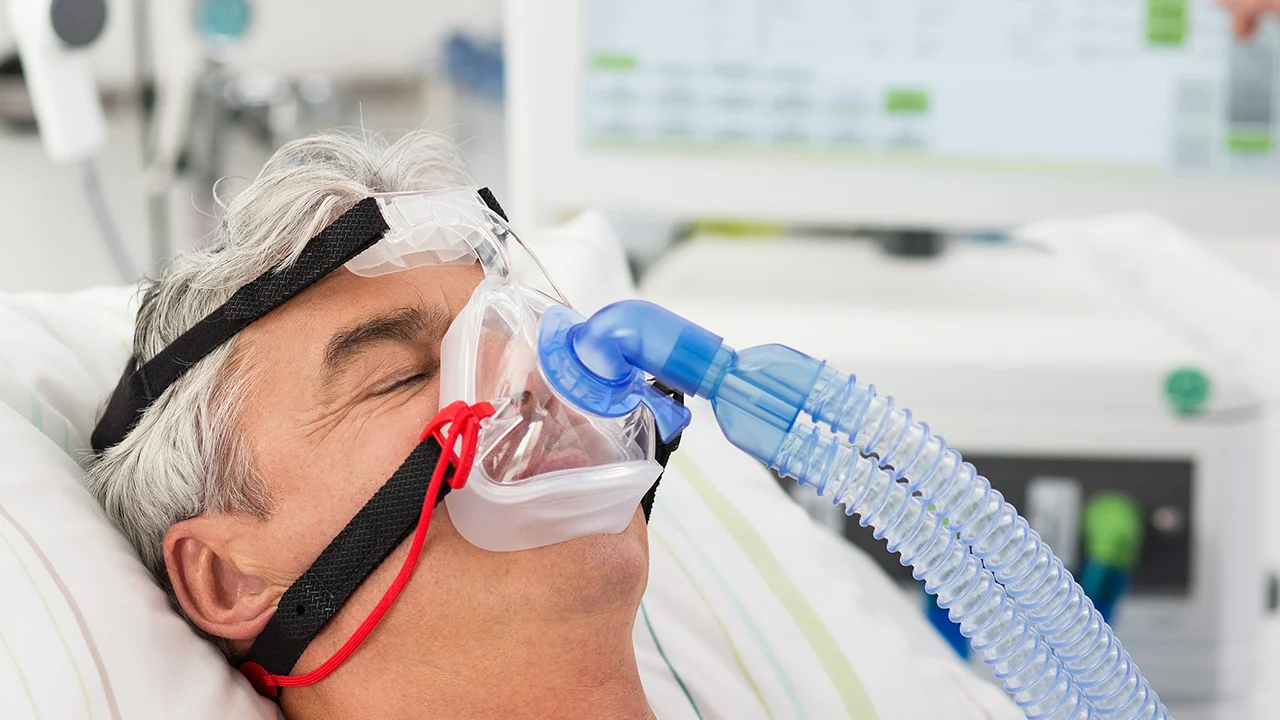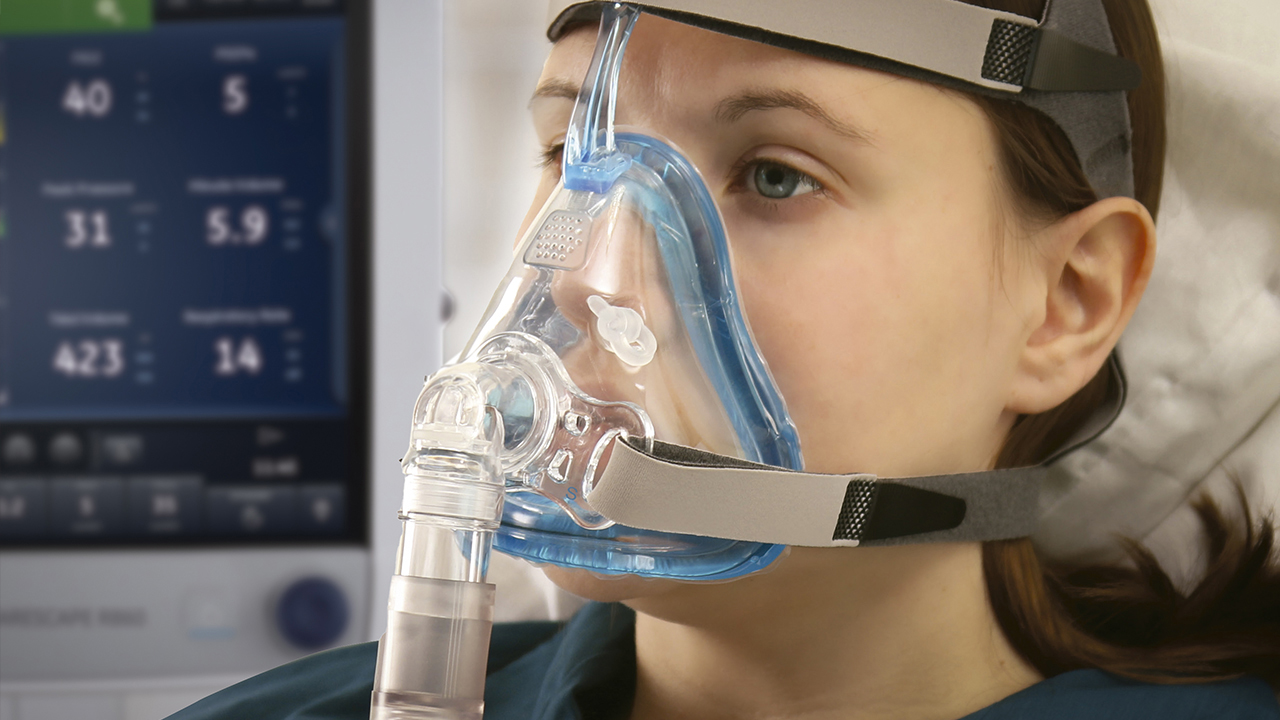Non-invasive ventilation (NIV) is an essential method of treating respiratory failure, whether acute or chronic. Unlike invasive ventilation, which requires an endotracheal tube or tracheostomy cannula, NIV uses a face or nasal mask to provide positive pressure without directly penetrating the airways.
This process improves gas exchange by reducing carbon dioxide in the blood and increasing oxygenation. It also reduces respiratory effort, while avoiding the complications associated with invasive intubation.
Used for pathologies such as sleep apnea syndrome, COPD or obesity-hypoventilation syndrome, NIV is an effective alternative in intensive care or at home. However, its success depends on rigorous monitoring to guarantee its efficacy and tolerance. This technique represents a major advance, offering adapted, less restrictive management.
What is NAV?
Non-invasive ventilation (NIV) is a method of mechanical ventilatory assistance that does not require the use of an invasive artificial airway, such as intubation or tracheostomy. It works by delivering positive pressure through a hermetically sealed mask covering the nose, or the nose and mouth. This enables the patient to breathe spontaneously, while receiving appropriate ventilatory support.
This technique ensures satisfactory alveolar ventilation by improving respiratory exchanges and reducing the concentration of carbon dioxide in the blood. Unlike invasive ventilation, NIV reduces the risk of complications such as infections and airway damage, often associated with intubation.
Several types of mask are used in NIV, ranging from nasal masks, which are often better tolerated because they take up less space, to bucconasal or facial masks, which offer a better seal. This system enables positive pressures to be applied according to the patient's specific respiratory needs.
NIV differs from invasive ventilation, which requires an endotracheal or tracheostomy tube inserted directly into the upper airway. The latter is reserved for patients with severe respiratory insufficiency or in emergency situations where NIV would not be effective.
Developed from the 1980s onwards, non-invasive ventilation enjoyed strong growth in the 2000s, notably to treat obstructive respiratory disorders, decompensated COPD and certain forms of chronic or acute respiratory failure. Today, it is a major component of ventilatory therapy, used in hospitals, intensive care units and even at home.
The different NIV modes

Non-invasive ventilation (NIV) is a technique that can be adapted to the specific needs of each patient, depending on the nature and severity of their respiratory disorders. The main NIV modes differ in the way the ventilator controls the volume of air insufflated and the pressure applied during the respiratory cycle.
The main distinctions are :
1. Pressure Support Ventilation (PSV): This mode supports the patient's spontaneous breathing by providing positive pressure during inspiration, thus facilitating the work of breathing without imposing a fixed volume. In addition, positive expiratory pressure(PEP or PEPAP) keeps the airways open during expiration.
2. Pressure-controlled ventilation: In this mode, the ventilator applies a fixed pressure for a set time, generating a variable volume of air depending on lung compliance and airway resistance. This mode is particularly used inacute respiratory failure, when the patient is less autonomous.
3. Volume-controlled ventilation: Here, the ventilator delivers a constant volume of air with each insufflation. Pressure then varies according to the patient's pulmonary characteristics. This mode is less common in NIV, however, as it can lead to discomfort if the pressure is not sufficiently adapted.
4. Mixed or programmable modes: Modern devices can combine pressure and volume, or alternate assisted and controlled phases (e.g. "assisted-controlled" mode). These modes offer great flexibility for optimizing respiratory management.
Ventilators used in NIV are often equipped with humidifiers to warm and humidify the insufflated air. This improves patient comfort and reduces dryness in the upper airways. These devices can be portable, making them suitable for use both in intensive care and at home.
The choice of ventilation mode depends on several factors: clinical indications, pathological context, but also the patient's tolerance and interactions with the mask and equipment. A thorough understanding of the different modes of NIV enables us to propose a personalized and effective treatment, minimizing discomfort while maximizing the chances of success of non-invasive ventilation.
Clinical indications for NIV

Non-invasive ventilation (NIV) is mainly used to treatrespiratory failure, whether acute or chronic. It is indicated when the patient has difficulty maintaining effective ventilation without resorting to invasive intubation. This method is particularly recommended in cases of acute decompensation of chronic respiratory diseases, such as chronic obstructive pulmonary disease (COPD). It reduces hypercapnia, improves ventilation and reduces the respiratory load.
NIV also plays an essential role in the management of sleep apnea syndrome. It helps maintain upper airway patency through continuous positive airway pressure (CPAP) ventilation. This prevents upper airway collapse during sleep, while improving sleep quality and oxygenation.
In situations ofacute respiratory failure, NIV is frequently used in intensive care to avoid intubation, particularly in the presence of hypercapnia associated with respiratory acidosis. This approach helps reduce infectious morbidity and complications associated with invasive ventilation, while increasing the chances of survival and reducing the length of stay in intensive care.
NIV may also be indicated in other situations, such as prevention of post-extubation respiratory failure, ventilatory weaning in chronic patients, or management of respiratory disorders in immunocompromised patients. In such cases, it must be used with caution and under close supervision to ensure its efficacy and avoid serious respiratory failure.
Finally, NIV can also be prescribed as a home mechanical ventilation treatment for patients suffering from chronic respiratory insufficiency. This approach helps improve quality of life and disease control outside the hospital setting.
Advantages and limitations of NAV
Non-invasive ventilation (NIV) offers many advantages, including increased patient comfort thanks to the absence of intubation and its less invasive nature. By using a mask to provide ventilation, it avoids the frequent complications associated with invasive ventilation, such as nosocomial infections linked to the endotracheal cannula or airway damage. In addition, this technique reduces respiratory effort by providing positive pressure support, helping to improve the quality of life of patients, particularly those suffering from chronic obstructive pulmonary disease (COPD ) or obesity-hypoventilation syndrome.
Another major advantage of NIV is its ability to shorten hospital stays and limit prolonged use of intensive care. This optimizes hospital resources and reduces resuscitation costs. In addition, NIV makes it easier to set up mechanical ventilation at home, giving patients greater autonomy while guaranteeing effective treatment of chronic respiratory insufficiency.
However, NIV has certain limitations. It is not suitable for patients with severely altered consciousness, severe upper airway obstruction or extreme respiratory failure requiring rapid invasive intervention.
The effectiveness of NIV also depends on mask tolerance. Some people may feel discomfort, experience air leaks or develop skin disorders due to prolonged contact with the equipment. Close monitoring is therefore essential to detect any NIV failures, which could lead to more severe respiratory decompensation if invasive treatment is delayed.
In short, NIV represents a compromise between efficacy and invasiveness. It offers respiratory support adapted to many patients, while limiting the risks and constraints associated with invasive ventilatory treatments.
Implementing NIV

NIV success and discontinuation criteria
Implementing non-invasive ventilation (NIV) requires a progressive, personalized approach. It begins with a rigorous selection of the most suitable mask and ventilator settings, defined by the physician. Trials are then carried out in hospital, generally in a pneumology or intensive care unit, to assess the patient's tolerance and the effectiveness of the treatment on respiratory function.
These preliminary tests enable us to prescribe a device that can be used at home, with appropriate follow-up. It is essential for patients to learn how to use the equipment, and for those around them to be kept informed. This helps patients to adhere more closely to their treatment and to manage NIV more smoothly on a day-to-day basis.
Successful NIV relies on several key elements: optimal mask sealing, good synchronization between machine and patient, and precise adjustment of ventilatory parameters. These adjustments are aimed at achieving measurable results, such as reduced carbon dioxide pressure in the blood and improved oxygenation. Gradual adaptation, often over several nights, is essential to optimize both patient comfort and adherence to treatment.
Criteria for discontinuation of NIV are defined by clinical signs of significant improvement: progressive normalization of blood gases, reduction in work of breathing and hemodynamic stability. On the other hand, if the situation deteriorates, if respiratory failure worsens or if the patient cannot tolerate ventilation despite adjustments, invasive ventilation in intensive care may become necessary.
In short, the implementation of NIV relies on careful monitoring, personalized technical adjustments and close collaboration between the patient and the medical and paramedical team. The aim is to ensure maximum efficiency while minimizing the risks and constraints associated with the treatment.
The role of the nursing team in the success of NIV
The nursing team plays a fundamental role in the success of non-invasive ventilation (NIV). Their involvement contributes not only to the successful implementation of ventilation, but also to its follow-up and day-to-day support of the patient. The effectiveness of NIV depends largely on effective coordination between doctors, nurses, physiotherapists and other healthcare professionals.
Physicians specializing in pulmonology or intensive care are responsible for establishing the indication for NIV, choosing the right type of interface and adjusting ventilatory parameters. Their expertise is essential in assessing clinical and biological responses, and adjusting treatment accordingly.
Nurses provide continuous patient monitoring, checking mask comfort and ventilation tolerance. They also play a key role in NIV education, providing advice and support, particularly during in-hospital or home sessions.
Their regular presence facilitates gradual adaptation of the patient, and enables rapid detection of any complications or signs of respiratory failure.
Respiratory physiotherapists work to maintain lung function, in particular by helping to manage bronchial congestion. They also teach assisted cough techniques, essential for optimizing the effectiveness of non-invasive ventilation, especially in patients with muscular weakness or chronic respiratory disorders.
In addition, the care team coordinates overall medical monitoring, including blood gas and respiratory parameters. They also liaise with the equipment maintenance and mechanical ventilation product management departments, to ensure comprehensive, efficient care.
This multidisciplinary collaboration makes it possible to offer individualized support, taking into account the patient's physical, psychological and social needs. This is crucial to the long-term success of NIV, whether in hospital or at home.
Impact of NIV on clinical outcome

Non-invasive ventilation (NIV) plays an essential role in the clinical evolution of patients suffering from respiratory failure. By improving ventilation and reducing the concentration of carbon dioxide in the blood, it alleviates the burden on respiratory muscles while promoting optimal oxygenation.
This process results in a marked improvement in respiratory symptoms, a reduction in acute exacerbations and a slower progression of chronic respiratory diseases such as chronic obstructive pulmonary disease (COPD).
In cases of acute respiratory failure, the use of NIV in intensive care often makes it possible to avoid invasive intubation. This reduces the associated complications and contributes to shortening the length of stay in the critical care unit. In addition, some studies show that NIV can improve survival, particularly in patients with significant hypercapnia at rest. This is because NIV provides effective respiratory support, improves gas exchange and optimizes lung function.
In the longer term, NIV, used at home as part of mechanical ventilation, helps stabilize respiratory function. It limits repeated hospitalizations due to respiratory decompensation, and improves patients' quality of life and autonomy. Regular use in accordance with the prescription is associated with greater treatment efficacy, thanks in particular to the reduction in blood carbon dioxide. This underlines the importance of rigorous monitoring and optimal support to guarantee results.
Finally, in cases of sleep disorders, NIV, via continuous positive airway pressure, plays an essential role in preventing obstructive apneas. This improves sleep quality and reduces the cardiovascular risks associated with these pathologies. Its use thus contributes directly to better overall health for patients with sleep-related respiratory disorders.
Conclusion
Non-invasive ventilation (NIV) represents a major advance in the treatment of respiratory failure. It offers effective support while preserving patient autonomy. Easily adaptable to different contexts, this method reduces the need for invasive ventilation and its complications, while improving quality of life. In some cases, it can even be used to manage patients at home.
The success of NIV depends on proper patient selection, rigorous implementation and attentive support from a committed nursing team. Don't hesitate to consult your doctor to find out whether NIV is right for you.
FAQ
What is non-invasive ventilation (NIV) and how does it work?
Non-invasive ventilation (NIV) is a method of mechanical respiratory assistance that delivers pressurized air through a face, nasal or bucco-nasal mask, without the need for intubation. This technique helps maintain an open airway and improve alveolar ventilation in patients suffering from respiratory failure, while reducing their respiratory effort.
What are the main medical indications for NIV?
NIV is mainly recommended in cases ofacute respiratory failure, especially for patients with chronic obstructive pulmonary disease (COPD), cardiogenic pulmonary edema or other respiratory failures accompanied by acidosis. It reduces work of breathing, limits the need for intubation and improves gas exchange, all of which contribute to a better prognosis.
What are the possible contraindications and risks associated with NIV?
NIV is contraindicated in certain cases, notably in the presence of altered consciousness, a high risk of aspiration, facial trauma, hemodynamic instability, airway obstruction or excessive secretions. Possible risks include aspiration, gastric bloating, pneumothorax and delayed intubation in the event of NIV failure.
How is an NIV session set up and monitored?
Implementation of NIV begins with the choice of a mask and appropriate adjustments, generally in a hospital setting. Patient and caregiver education is also provided. At home, NIV is installed with precise parameter control, follow-up questionnaires, regular adjustments and nocturnal recordings. Patient tolerance and respiratory efficiency are periodically assessed, so that treatment can be adapted if necessary.




